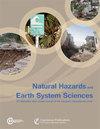Slope Unit Maker (SUMak): an efficient and parameter-free algorithm for delineating slope units to improve landslide modeling
IF 4.7
2区 地球科学
Q1 GEOSCIENCES, MULTIDISCIPLINARY
引用次数: 0
Abstract
Abstract. Slope units are terrain partitions bounded by drainage and divide lines. In landslide modeling, including susceptibility modeling and event-specific modeling of landslide occurrence, slope units provide several advantages over gridded units, such as better capturing terrain geometry, improved incorporation of geospatial landslide-occurrence data in different formats (e.g., point and polygon), and better accommodating the varying data accuracy and precision in landslide inventories. However, the use of slope units in regional (> 100 km2) landslide studies remains limited due, in part, to the large computational costs and/or poor reproducibility with current delineation methods. We introduce a computationally efficient algorithm for the parameter-free delineation of slope units that leverages tools from within TauDEM and GRASS, using an R interface. The algorithm uses geomorphic laws to define the appropriate scaling of the slope units representative of hillslope processes, avoiding the often ambiguous determination of slope unit size. We then demonstrate how slope units enable more robust regional-scale landslide susceptibility and event-specific landslide occurrence maps.斜坡单元制作器 (SUMak):一种用于划分斜坡单元的高效无参数算法,可改善滑坡建模
摘要斜坡单元是以排水线和分界线为边界的地形分区。在滑坡建模(包括易发性建模和滑坡发生的特定事件建模)中,与网格单元相比,斜坡单元具有若干优势,例如能更好地捕捉地形几何形状,更好地纳入不同格式(如点和多边形)的地理空间滑坡发生数据,以及更好地适应滑坡清单中不同的数据精度和准确性。然而,在区域(大于 100 平方公里)滑坡研究中,斜坡单元的使用仍然有限,部分原因是计算成本高和/或当前划分方法的可重复性差。我们介绍了一种计算效率高的无参数斜坡单元划分算法,该算法利用 TauDEM 和 GRASS 中的工具,并使用 R 接口。该算法利用地貌规律来定义代表山坡过程的斜坡单元的适当比例,避免了通常模棱两可的斜坡单元大小的确定。然后,我们演示了斜坡单元如何实现更强大的区域尺度滑坡易发性和特定事件滑坡发生图。
本文章由计算机程序翻译,如有差异,请以英文原文为准。
求助全文
约1分钟内获得全文
求助全文
来源期刊
CiteScore
7.60
自引率
6.50%
发文量
192
审稿时长
3.8 months
期刊介绍:
Natural Hazards and Earth System Sciences (NHESS) is an interdisciplinary and international journal dedicated to the public discussion and open-access publication of high-quality studies and original research on natural hazards and their consequences. Embracing a holistic Earth system science approach, NHESS serves a wide and diverse community of research scientists, practitioners, and decision makers concerned with detection of natural hazards, monitoring and modelling, vulnerability and risk assessment, and the design and implementation of mitigation and adaptation strategies, including economical, societal, and educational aspects.

 求助内容:
求助内容: 应助结果提醒方式:
应助结果提醒方式:


